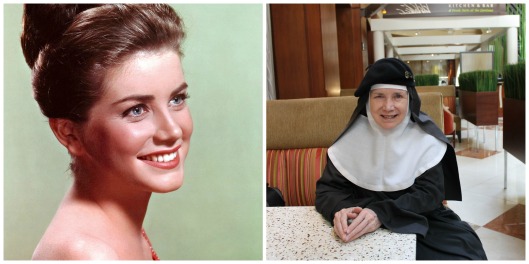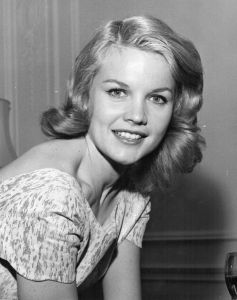She gave Elvis his first on-screen kiss.
Roles in “The Courtship of Eddie’s Father” and “The Ticklish Affair” that later went to Shirley Jones were originally offered to her.
Her career began in 1957 with the film “Loving You” along side Elvis Presley and ended in 1963 with the film “Come Fly with Me.”
But at the height of her career in 1963, Dolores Hart left Hollywood to follow a vocational calling to become a nun.

Dolores Hart in the 1960s and now as Reverend Mother Dolores today (Comet Over Hollywood/Jessica Pickens)
“I am not leaving anyone or anything behind me. I am taking with me a full and grateful heart,” Hart left as a statement with her publicist.
The media frenzy that followed cited her broken engagement with her former fiancé Don Robinson. The National Enquirer headline read “Star Driven into Nunnery by her Love for Elvis.” Colleagues and friends were dumbfounded.
To Hollywood, family and friends, Hart’s decision to become a nun may have seemed rash. But her choice was a long road of exploration of her faith that was triggered by her first visit to the Abbey of Regina Laudis in 1958.
Hart published the book “The Ear of the Heart: An Actress’ Journey from Hollywood to Holy Vows” in May that explores her parent’s tumultuous marriage, why she became a Catholic, her career as a film star and her life as a nun.
Her parents had the desire to become Hollywood film stars. However, her father Bert Hicks mainly played bit roles. Her parents divorced while she was still young. While attending Catholic school, she decided to convert so she could have hot chocolate and cinnamon rolls with the other children.
She is often asked if her role as Saint Claire in “Francis of Assisi” (1961) is what influenced her decision to become a nun. The role had no effect but meeting Pope John XXIII while filming left an impact on the actress.
Saturday morning, I had the privilege to meet with Dolores Hart in Charlotte, NC before she spoke at the Charlotte Eucharist Convention. “Ear of the Heart” is one of the best celebrity autobiographies I have read. Rather than full of gossip and salacious rumors, it discusses her journey through life. I couldn’t help but feel calm and soothed every time I picked it up.
We met and spoke about her book as well as her time in Hollywood and at Regina Laudis.
Though she was a little older and was dressed in a nun’s habit and robe, her smile and sparkling clear blue eyes were the same ones you see in her films such as “Where the Boys Are.”
Revered Mother Dolores was warm, personable and an overall lovely woman.

Reverend Mother Dolores and myself in Charlotte, NC on Sept. 14
Q: Tell me about the Eucharist Conference you are in town for today.
I’m actually not that familiar with it because I have been in an enclosed monastery. I don’t remember anything like this before I entered. It’s wonderful seeing the intensity of love for the sacrament…Not love in the usual form of the word but transcending love that can hold the passion of and sadness of life.
Q: What influenced you to write the book?
I think it’s because my old friend Dick DeNeut encouraged me to do it. He told me if I didn’t write it soon, I would forget everything. We started in 2003 and it has taken a long time to put it in its present form. I’m fortunate to have someone like Dick. He knows me so well and we were very close. We have had strong communication for decades. I think the beautiful part of the preparation is that he would always be frank with me. He wouldn’t say things that made me feel good but would be frank in order to awaken and receive an honest response.
Q: Which Catholic celebrities in Hollywood supported your decision?

Dolores Hart with George Hamilton in “Where he Boys Are”
Hart discusses in her book being friends with other Hollywood Catholics during her stardom such as Irene Dunne and Loretta Young. She once was invited to speak at a Jesuits’ Church of the Blessed Sacrament breakfast in 1958 that was attended by Catholic celebrities.
June Haver was one of the most faithful friends I had in Hollywood, and so was Patricia Neal. Others were complimentary. June would visit several times a year and try to find ways to help us. She loved visiting our dairy farm and working with the farm animals. Once she asked how the pigs reproduce. We told her we had a semen tank, but it was actually running low. She said that was how she would help us. Well, the local newspaper in town heard about it and came out with a story saying June Haver was buying nuns a semen tank. It was hysterical. But she would come to visit us on a yearly basis.
Q: How often were you compared to June Haver, who once entered as a nun and later left?

Dolores Hart with Elvis Presley in 1957 in a still for “Loving You”
When I first started considering, Mother Benedict told me to take some time to put everything in order so I wouldn’t become another statistic. I didn’t know June at the time and I wasn’t aware of her personal struggles. She once entered as a nun herself and left. When we finally met I could perceive the depth of goodness and that she had struggled a great deal. She was very honest and never claimed what wasn’t true. She was a great lesson to me.
Q: How did Hollywood help or hurt you in a cloistered community?
I didn’t understand in the beginning how I could benefit from my Hollywood experiences. I accept the time in Hollwood as part of God’s will. I appreciate the goodness of the venture. I didn’t leave to reach for something better or a higher value.
People in the industry are so open. Producer Hal Wallis saw some sort of value in me to give me a seven year contract. He was furious when I left and told me not to bother coming back to work for him. I understood that because I was breaking professional expectation of truth. That was a profound step in his reality of life. But then after 15 years, he broke down and we became friends again. His wife Martha Hyer still sends us a basket of fruit every year.
My agent Harry Bernson sent me a note and asked if I had swallowed razor blades and said I had committed suicide. But then he eventually saw it was the right thing.
Those friendships shown to me by a number of actors showed me integrity of human values in every religion.
Q: If you hadn’t left Hollywood, how do you think your career would have ended up?
If I hadn’t left Hollywood, we probably wouldn’t be talking right now. The interest in me wouldn’t be there. People are interested because I became a nun.
I don’t think my career would have petered out, but then I have seen so many people come and go and you never see them again. Depending on roles, most women in Hollywood only work until their early 40s. You can’t bank on your career being a given.
My grandfather was a movie projectionist and had seen all the films. When I got older, I confessed to him that I wanted to become an actress. He told me he had seen them all and knew I would be the best at it. For a grandfather to say that was the best possible compliment.
Q: You also left Hollywood right before things began rapidly changing. Were you aware of the changes in Hollywood with the studio system?
Because I was still a member of the Academy, I still had an interest in what was happening with the studios, but I don’t remember judging it. People say that the film industry is what led the way to society changes. I could tell changes by the way people talked and dressed. There was a deeper sense of fear that life wasn’t worth much. I noticed people were dressing sort of in a dumpy way. I couldn’t believe a woman would wear jeans and high heels in the airport. That was really campy to me.
I think the film industry really reflected what was going on in society. They were always champions in exfoliating what was going on with people.

Hart with fan mail in 1960
Q: How much fan mail do you receive each year?
It depends on what’s going on. As I have been on tour for the book, I have received a considerable amount. I usually receive two or three letters a day. By the end of the week it turns into a mountain of mail, so it’s a continuous obligation. When the documentary “God is Bigger than Elvis” came out two years ago, the situation changed. We did the film and it was my break through back into public life. I got so much fan mail after and I had to have some of the sisters help me stamp and address letters.
Q: One last question, do you still watch any of your movies?
I have seen them so often that they bore me. I will watch them though if someone requests to watch a movie with me. Sometimes I discover something new by a question they present. The community doesn’t want to see my movies anymore, because they are tired of them.
For more on her kiss with Elvis and acting with Montgomery Clift stay tuned to Comet Over Hollywood in the coming days for a full book review.
Check out the Comet Over Hollywood Facebook page, follow on Twitter at @HollywoodComet or e-mail at cometoverhollywood@gmail.com
Love what you read? Share it:





















